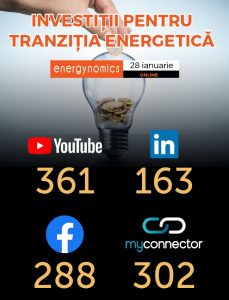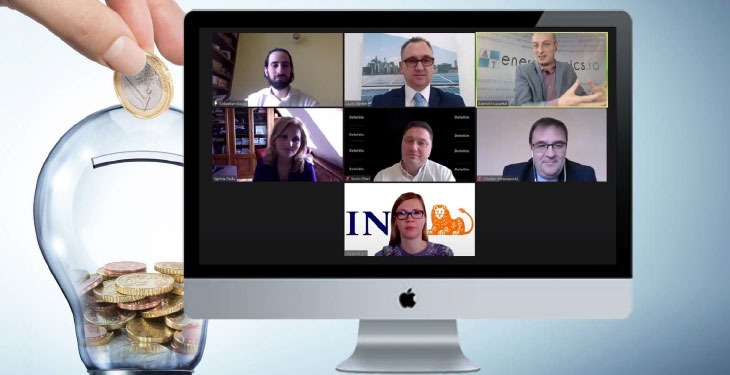Over the next few years, Romania can benefit from a wave of investments in all energy sectors. A stable and predictable strategic and implementation framework will enable European funds and private money to tap into the excellent potential for the development of the renewable industry and other various natural resources. Legislative changes, which will include the transposition of the new legal provisions and European action plans, will play an important role. The “Investments for Energy Transition” conference, organized by Energynomics, on 28 January, brought together six experts who presented the opportunities and challenges visible at the start of the year and answered questions raised by the participants in the MyConnector online platform. The event was supported by BCR, ING Bank Romania, Kawasaki Gas Turbines Europe GmbH, Photon Energy.
Romania has an excellent potential for the development of the renewables industry, says Varinia Radu, Head of Energy Romania, CEE Deputy Head of EPC, CMS. (See her speech in the conference!) If 10-15 years ago, the renewables industry needed support schemes to meet its performance indicators, lower price of technologies and a green, more favorable policy have created new market conditions, much more attractive for investors. At the same time, increasing investment in generation, but also changing the existing portfolio of parks that have already reached their lifetime will create additional pressures on the national transport system – and the resilience and capacity of the network to assimilate new capacity must be ensured by new network investments. Investments in the national transport network mean not only local development, but also functional interconnections with regional networks, said Varinia Radu.
S. Elisei: Investors in Romania need a stable and predictable strategic and implementation framework
Romania has to reach the objective of climate neutrality in 2050, with an intermediate threshold in 2030. In order to understand the energy transition, we must understand the whole context and have clear communication, especially from the perspective of Romania’s position on taxonomy and the role of natural gas, said Sorin Elisei, Energy & Resources Industry Director, Deloitte. (Read full article! See his speech in the conference!)
“The discussion about transition is an important one as the range of funding become clearer. Investors, however, need a well-defined strategic and institutional framework. This strategic framework is to show where the Romanian state will favor investments – in which areas. There is a lot of money, but they should be well distributed,” he said.
“Regarding the sources of financing, we can discuss projects based on commercial perspectives, where the market provides investors with the price signal and the stable and predictable framework for such an investment to recover. We are talking about 20-25-year recovery cycles for some big investments. We still have work to do on the legislative framework. We still lack a form for bilateral contracts (PPAs) that we see in other countries. Then, we want to access various instruments – the Modernization Fund, structural funds, the Just Transition Mechanism, state aid schemes.”
Staicu, BCR: Romania needs to better define the investments it wants
By 2020, European carbon emissions have been reduced by more than 24% compared to 1990. During the same period, the economy grew by 60%, said Sebastian Staicu, project Finance Manager, BCR. “It is clear that we can decouple economic growth from carbon emissions”, he stressed. (Read full article! See his speech in the conference!)
“There are four main pillars of investment: consumption, transport, energy production and resources, which together can probably amount to around 50 billion euros”, Sebastian Staicu summed up. Investments in the energy sector include projects dedicated to energy consumers, and estimates talk about around €12,8 billion dedicated to building renovation, which is higher than the amount required for generation.
These are legislative initiatives and investments for the gas area, especially those concerning regional interconnection. “Transgaz has the prospect of supplying gas in the Republic of Moldova, we have new discoveries in the Black Sea and the Offshore Law will be amended. On the other hand, there are all sorts of barriers in the renewable area, high costs for grid connection, high balancing costs and very inflexible electricity trading tools, especially for renewable power”, Staicu noted.
The PPA market is growing
PPA-type contracts are now possible for new capacities, and we expect changes to the Energy Law soon, so that they are allowed in line with the European Directive and Regulation 943 and 944.
“There are more and more projects that do not need a subsidy and then PPAs become increasingly important as the main source of revenue. The market is highly volatile, but at 50-60 euros/MWh, PPAs can also be concluded”.
DOWNLOAD THE PRESENTATION OF SEBASTIAN STAICU
PPAs also plays an important role in the CfD scheme, Staicu said. A CfD-type scheme will block prices, but there is a need for PPAs “to avoid long-term volume risks”. In the field of municipal heating, PPAs can also be important for securing contracts for gas-based production. “Automatically, PPAs reduce project risks and banks can come with higher amounts and lower interest rates for credits associated with such projects,” Staicu explained.
Oana Mogoi, ING Bank Romania: Investors’ appetite for green bonds is on the rise
In recent years, most large banks have adjusted their policies to restrict access to finance for certain technologies, fuels or projects that are not in line with the energy transition and, in return, to direct their funding to support transition and sustainable investments, says Oana Mogoi, Head sector, Utilities & Natural resources, ING Bank Romania. (Read full article! See her speech in the conference!)
“The project under the aegis of the National Committee for Macroprudential Oversight aims, along with BNR, the Presidential Administration, the ministries of interest and commercial banks, to accelerate the provision of sustainable financing for green projects,” said Oana Mogoi. “The idea of sustainability has taken shape in ING since 1996, when the first sustainability report was issued, the goals were set in 2010 and in 2014 sustainability became part of the ING strategy. Since 2015, when the first green bond was brokered, things have advanced fast and green finance products have diversified. This gives us a privileged position in the market, as can be seen from the ratings of the various sustainability rating agencies.
DOWNLOAD THE PRESENTATION OF OANA MOGOI
We can intermediate green bonds, if the funds attracted are used for sustainability-related projects and initiatives, or projects for which a sustainability target is defined, which is linked to the coupon. In 2019, ING brokered 62 such issuances globally, and in 2020 we managed to structure the first green bond for a customer with business in Romania; it is true, not in the energy sector – but we showed that we could do it and I hope that others would follow.” Mogoi said.
Photon Energy develops solar projects of more than 790 MW, 10% in Romania
Photon Energy currently develops solar projects of various sizes totaling over 790 MW worldwide, of which 77 MW in Romania and 96 MW in Hungary, said Lauru Bădiță, Country Manager Romania. (Read full article! See his speech in the conference!)
For energy transition, Photon Energy group focuses on two lines of activity: clean energy and water – around which solutions will be developed in Romania and in all countries where the group is present. Its own projects portfolio is currently around 75 MW and will grow to 115 MW by 2022.
DOWNLOAD THE PRESENTATION OF LAURU BĂDIȚĂ
Lauru Bădiță also referred to the challenges of the Romanian market. “Although our country’s 2030 target shows a 30,7% share of renewable energy in the energy mix, there are still some things to be done from a legislative point of view. I am thinking first and foremost of the possibility of concluding bilateral contracts outside the centralized market. Then, there are difficulties in purchasing agricultural land – the necessary amendments should be identified to allow the development of clean energy in parallel with agriculture. The option of buying land outside the built-up areas is very difficult, which also has an impact on our access to financing. Other important topics for investors are access to the grid and connection costs,” he said.
Athanasovici, Kawasaki: We offer financing solutions through our European branch
Until 2030, Romania cannot give up on natural gas, so it will have to very intelligently combine hydrocarbon-based and renewable resources, according to Cristian Athanasovici, Business Development Manager, Kawasaki Gas Turbines Europe. As a novelty, Kawasaki Europe is ready to co-finance local cogeneration projects, he announced. (Read ful article! See his speech in the conferince!)
“Last year we signed a deal with a partner to finance energy efficiency projects based on solutions made with Kawasaki equipment. We have this agreement signed, and we are ready to present it and finance up to a maximum of 12 million euro, with a duration of 10-12 years. The Energy Efficiency Investment Fund finances the Kawasaki Europe projects and it has nothing to do with the final customer – the end user of the cogeneration plant. This fund finances Kawasaki, which delivers the cogeneration equipment, provides long-term maintenance and remains the owner of the equipment until the moment the final customer pays for the equipment. We can assimilate this concept to a leasing – which is very important from the perspective of the balance sheet of the final customer. Our colleagues analyze the customer’s situation, the market, and depending on the risks identified, we discuss the detailed financing conditions, i.e. guarantees, interest and other issues. The condition is that maintenance, after delivery and commissioning, is done by Kawasaki,” Athanasovici explained.
DOWNLOAD THE PRESENTATION OF CRISTIAN ATHANASOVICI
“Kawasaki is ready to offer high-performance technologies for power and heat generation on both natural gas and hydrogen. We already have a hydrogen application in Japan. We hope to bring a new project to Europe, one that has been under discussion for over a year and a half,” Athanasovici said.
The “Investments for Energy Transition” conference was organized by Energynomics with the support of our partners BCR, ING Bank Romania, Kawasaki Gas Turbines Europe GmbH, Photon Energy.

